
I endured 6 hours of North of Falcon zoom meetings to bring you these fresh-off-the-grill salmon forecasts for the year 2024!
Okay, it wasn’t that bad. This forecast “unveiling” was the beginning of the North of Falcon process, wherein the salmon seasons get set and eventually printed prior to the July 1st new regulations year.
If you’re already confused, you are in good company as the entire process of salmon forecast models and the resulting seasons leave a lot of recreational anglers who are only semi-familiar with the process scratching their heads.
I’m thinking of a drinking game where each time a participant asks how the department knows that Stillaguamish River chinook are caught in Marine Area 11, take a shot!
We wouldn’t make it very long!
This blog post is here to try and explain some things. I’m also planning to do a virtual review of this material and attempt to answer questions and take concerns, and ideas from you all that I can try to represent in future NoF meetings.
Make sure you are subscribed to my YouTube channel (PNW Best Life), but I’m aiming to host the live session around 2-3 pm PST on Sunday, March 3rd.
Let me start with the obvious and good news. There are lots of chinook and coho returning to the Puget Sound, Columbia, and Washington Coast and we are going to get to fish for them!
I hope you keep reading for more details!
I like to divide this topic into several different categories and areas to help us process the information.
There are primarily transient Marine Areas such as Area 4B, 5 – Sekiu, 6 Port Angeles, and 9 Admiralty Inlet and then there are Marine Areas that have terminal areas within them such as Marine Areas 7, 10, 11, and 13.
The way to think about the abundances in each of these areas changes slightly when you consider the migratory path that most of Puget Sound Salmon take on their way to their natal streams.
It also should be noted that the entire area from roughly Tatoosh Island east towards Puget Sound and south through the interior are managed as “mixed stock fisheries.” That means that each stock of chinook or coho is managed separately and their abundance or lack thereof are considered as input into the Fishing Regulations Assessment Model (FRAM).
You should also know that natural origin Puget Sound Chinook are ESA listed, so being able to fish for any chinook in Puget Sound means complying to a bunch of federal management frameworks.
That also means that our opportunity is largely constrained by the weakest stock. There are all kinds of debates and controversies as to how this is managed since we primarily conduct mark-selective fisheries (release natural origin salmon with adipose fin intact) which have limited impact on stocks of salmon of natural origin.
I would have to write several more pages just to do that back-and-forth any kind of justice, so I’m going to leave it alone and just focus on the salmon forecasts.
And with that, let’s dig into the abundance reports on 2023 and go from there to the 2024 forecasts.
How was the 2023 Salmon Return in Puget Sound?
It’s important to start our understanding of the 2024 forecast by looking back at how 2023 performed.
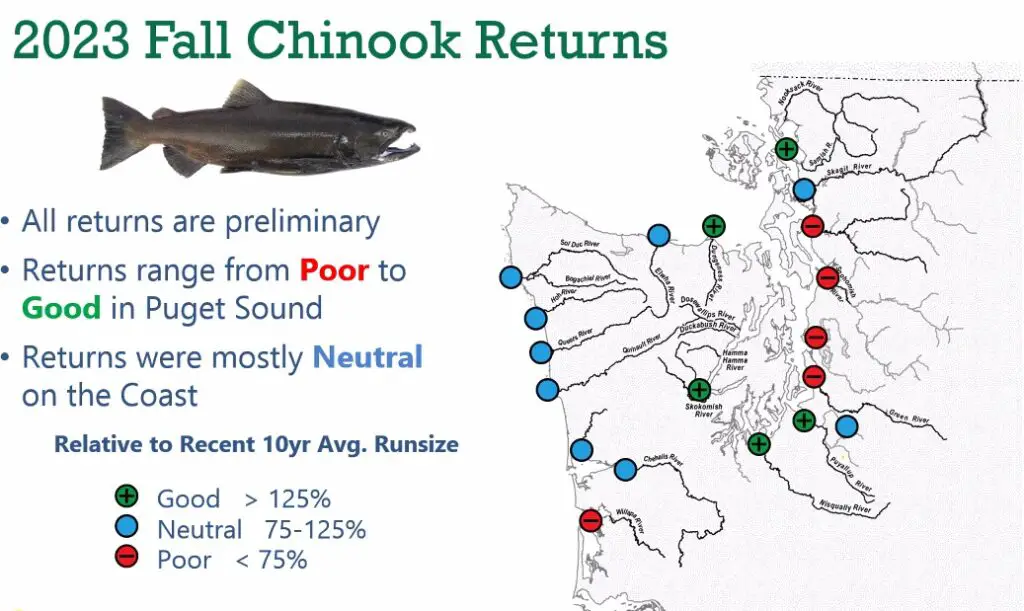
It’s troubling that the Central to North Sound rivers are largely what’s in the red since these rivers have been many of the stocks of concern lately. Hugely disappointing returns on the Stillguamish and the Snohomish systems will impact us in our 2024 season setting.
We could especially see opportunities limited in Marine Area 7, and some of the transient areas to the west (4b,5,6,9). I’m also curious what’s going on with the Green River chinook return as I thought that was in good shape last year…
The Nisqually surprised me on this slide as being in the green since last year the forecast was cautious…
Let’s take a look at coho now.
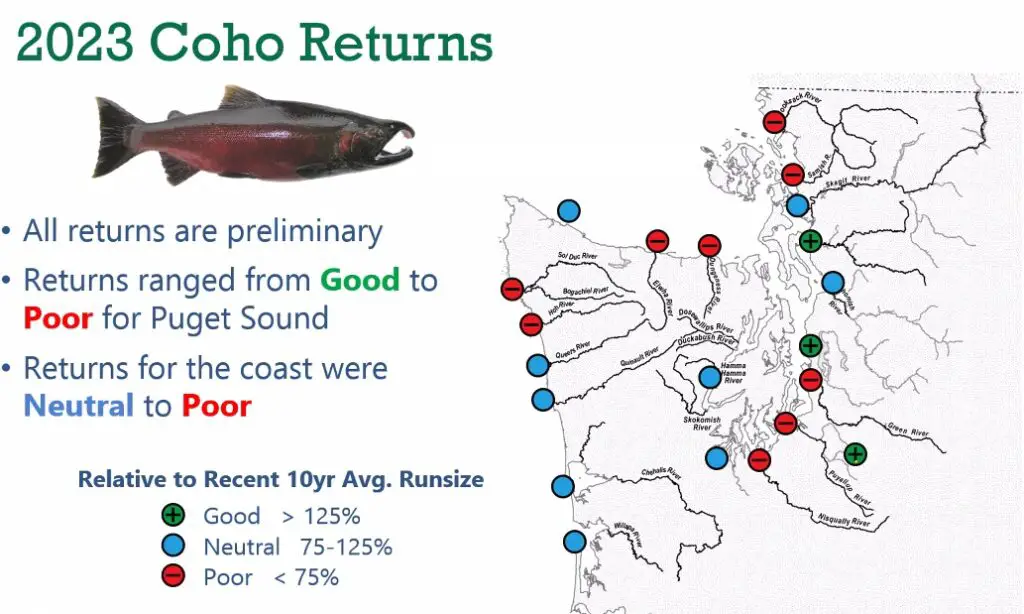
For coho salmon, there seems to be a mix of South and North Sound problematic returns, with a few bright spots in places like the Stillaguamish and Snohomish.
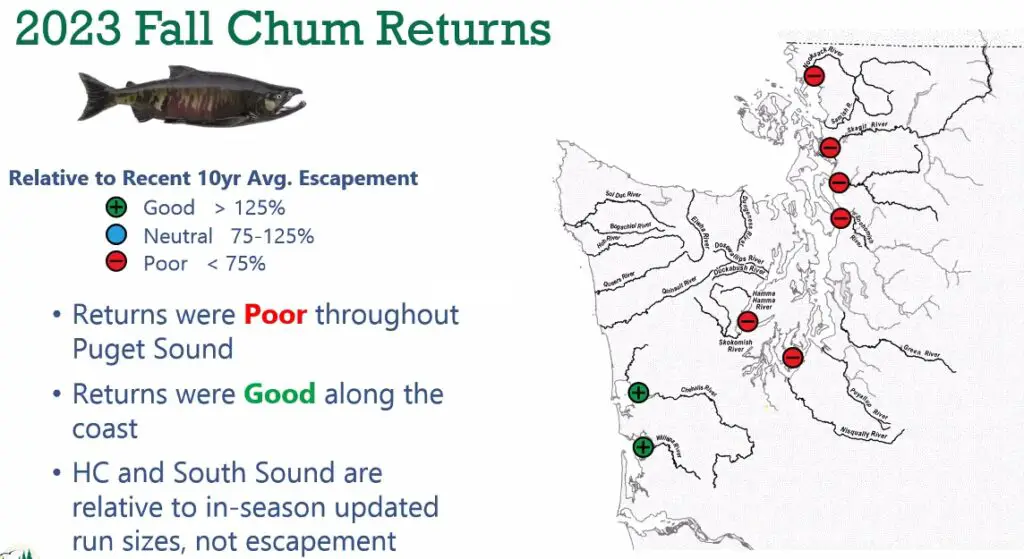
In terms of chum, this is not what we want to see…pretty much all poor returns in 2023.
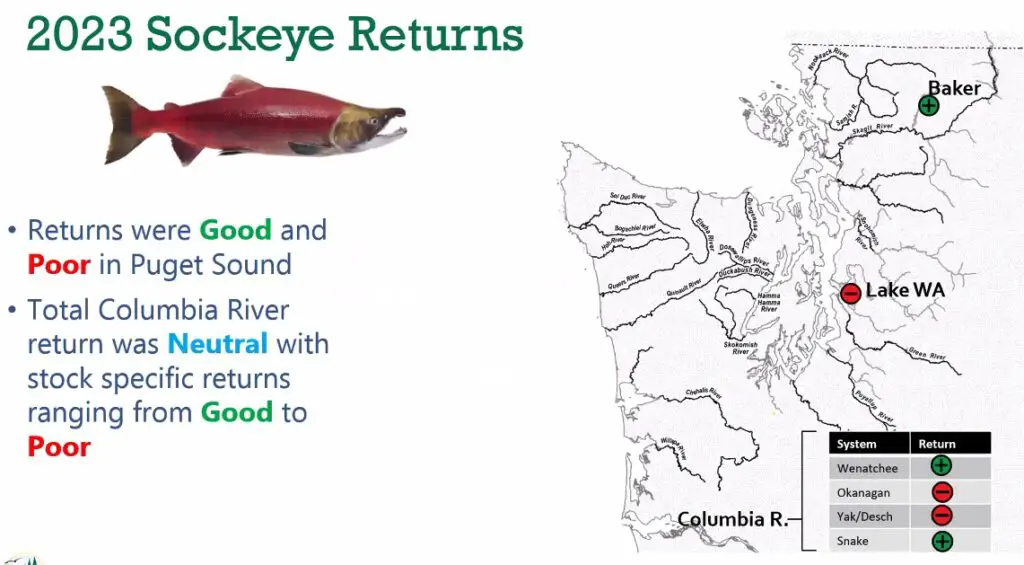
There is some good news here and some continued expected bad news of Lake Washington Sockeye not recovering.
You’ve gotta be excited about what’s going on at Baker Lake though! Baker just continues to outperform and you will see more of that in the 2024 forecast.
What are the 2024 Puget Sound Salmon Forecasts?

That cluster of green in the South Sound has me excited to fish for chinook throughout August in Marine Area 13 this year, along with the other areas on the migration route earlier in the season.
A significant portion of the discussion and Q&A focussed on the closure of Marine Area 11 in 2023 which left most of the harvestable chinook quota on the table due to the in-season management issue of hitting the sub-legal encounter quota.
Again, I’m not going to try and address that here. Just know that an early closure to any of these fisheries is still a big risk. One of the mitigating steps could be to delay the openers of the primary summer season to match when the bulk of migrating adult chinook show up, but there’s a lot more to that discussion as well.
Based on these forecasts I would expect similar seasons in the transitory Marine Areas listed above as we had in 2023 and pretty decent fishing as well.
Again, what happens in Marine Area 7, 10 and 11 are going to depend heavily on these stocks of concerns and in-season management frameworks that have a lot of detail still to figure out.
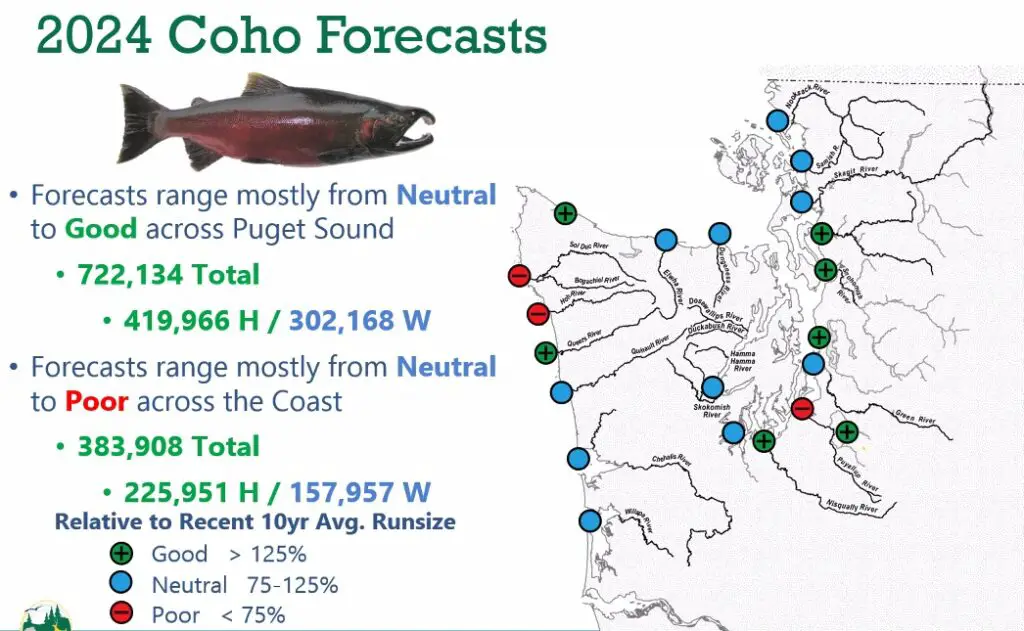
We should expect good coho fishing again in 2024. I don’t know that the resident coho season will be quite as good as it was in 2023, which was record breaking ridiculous, but I’m still expecting good fishing if we get the 700,000+ coho back.
I’m bummed that the single red dot may impact season on the Puyallup River as I’m sure one of the component runs has a less than stellar return expected.
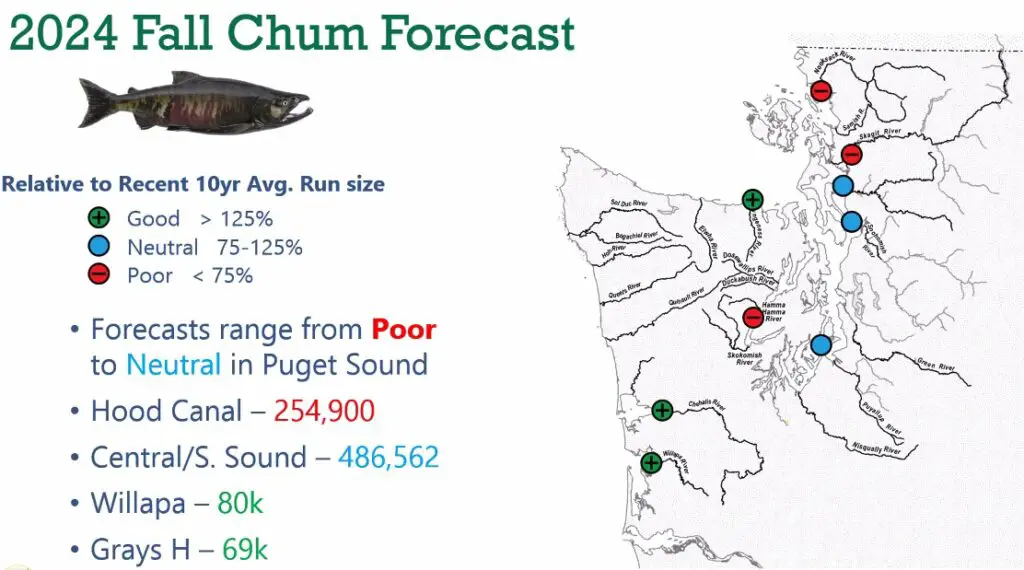
As we saw from the 2023 numbers, chum returns were poor all over the place. 2024 should result in some decent returns for Central and South Sound at least.
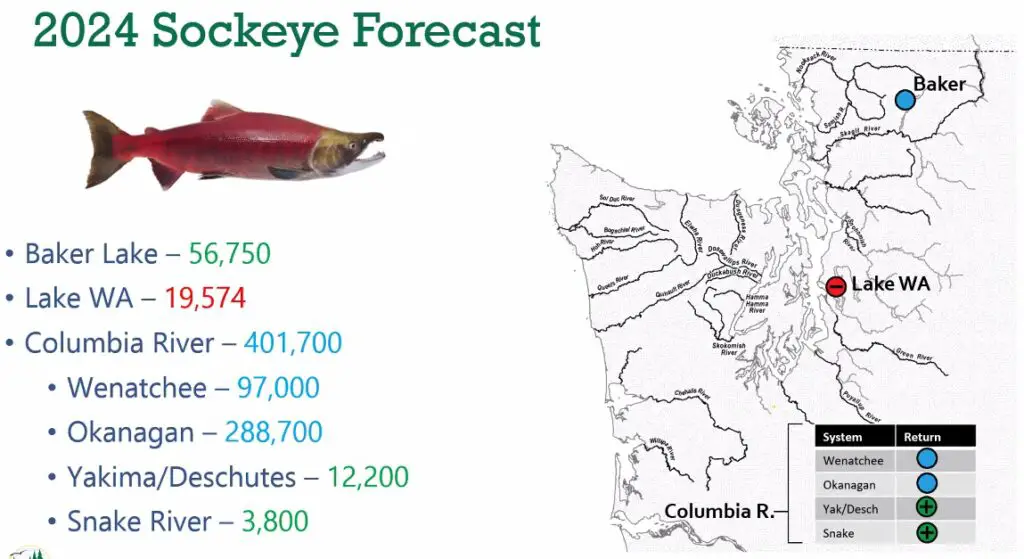
The real great news of the 2024 salmon forecast is the outstanding return expected for Baker Lake sockeye! Coupled with good numbers on the Columbia River, there should be lots of opportunity for sockeye anglers in 2024!
Baker Lake is a long ways for me, but I may get a chance to spend a day on the water up there!
What are the biggest risks to our 2024 fisheries?
Now that we got through the surface fluff, tell me what’s really going on! I come to this blog for the nitty gritty details not the same information I can get anywhere else!
Okay, you’re on, buckle up!
The first way of approaching the risks to our 2024 fisheries is to focus on stocks of concern. The way this is done is something called NALF or New Abundance Last years Fisheries.
In other words, now that we have all the forecasts (we are still missing a few like Nooksack Spring), let’s run 2023’s fisheries through the initial model runs and see what comes out as potentially being above or close to the maximum exploitation rate or ER%.
These ER%’s get set as part of the fisheries management framework and are either managed as a total ER, a Southern US (SUS) ER or Pre-Terminal Southern US (PT-SUS) ER%.
Stay with me!
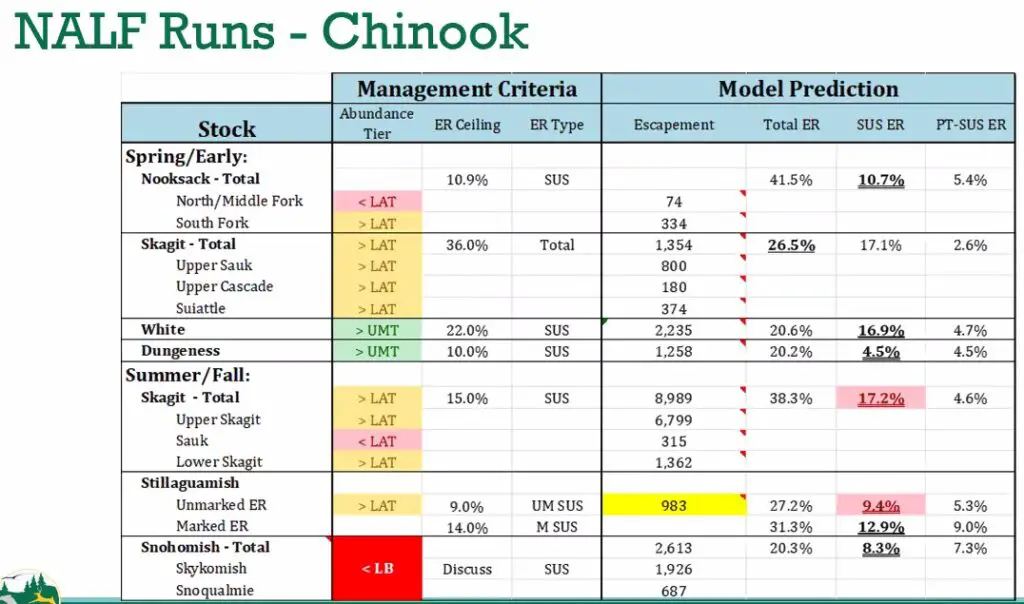
Here’s the NALF run for the North Sound and Spring / Summer returning chinook salmon.
A few things should jump out to you.
- We don’t yet know what’s going on with the Nooksack until the 2024 forecast is released.
- Skagit Summer / Fall is estimated to be over the SUS ER Ceiling, but only 4.6% of the ER is pre-terminal, which means the river fishery may take the brunt of the impact to fishing seasons.
- The Stillaguamish is still a problem and is expected to be above the 9% ER Ceiling on Unmarked fish. This could impact in-river tribal fisheries or marine harvest quotas.
- Sadly, the Snohomish is still in big trouble. The Snoqualmie component is below the LB (lower bound) threshold which means any SUS ER is a negotiation with co-managers.
The only positive on #4 (Snohomish risk) is that apparently it was also here in 2022 and there was not a major impact to our seasons.
Of course, if you know the Snohomish River situation you know we got hit on our in-river summer chinook opportunity in a big way in 2023.
Sadly, the NALF 8.3% number DOES NOT include a robust in-river chinook opportunity since there wasn’t one in 2023. So anything in 2024 would be above that 8.3% number, which has to come from somewhere and most likely it will need to come from marine areas giving up harvest quota.
Now, some marine areas may give up harvest quotas anyways when trying to satisfy concerns on river like the Stillaguamish, but it’s way too early to figure out how that will play out.
For reference here’s what the 2023 NALF looked like:
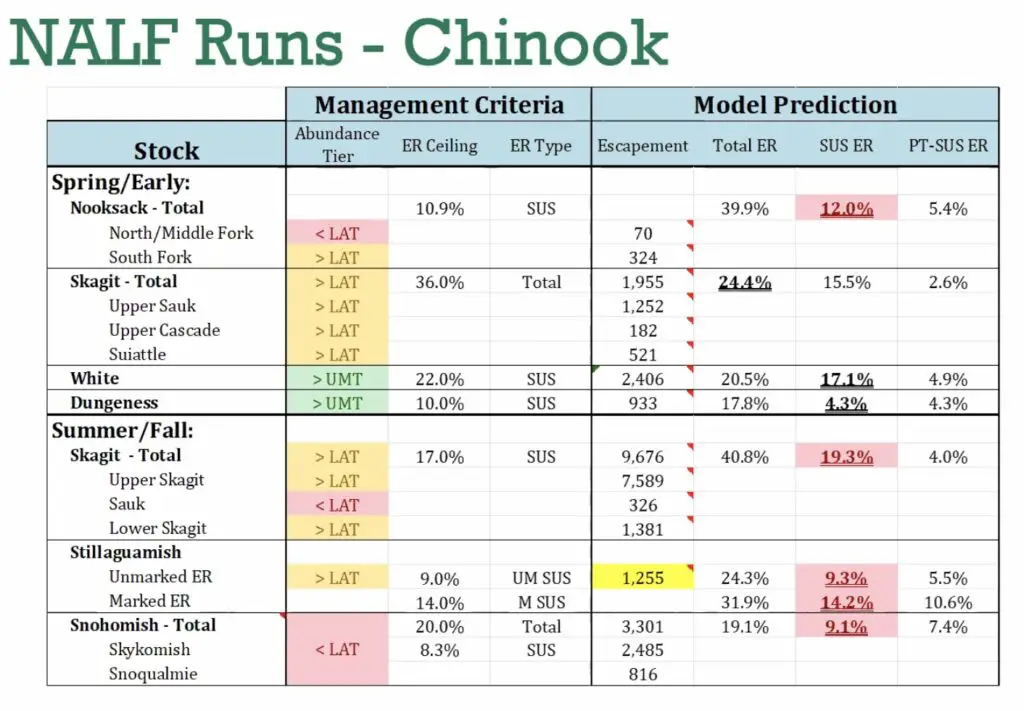
We had a SUS ER Ceiling of 8.3% and we came in at 9.1% with the in-river chinook fishery, which was largely sacrificed to come in below the 8.3% ceiling.
If you’re following along and my math is correct, we need about .7% ER carved out for an in-river chinook fishery. Perhaps we can meet things half way? Let’s hope something can be done to improve on last years minuscule in-river chinook opportunity.
I will have much more on this topic as we go through the process.
I will also be updating my content on all my in-river pages to reflect these forecasts as I get to it all.
How does 2024 compare to historical runs of Chinook and Coho Salmon?
I thought you would never ask!
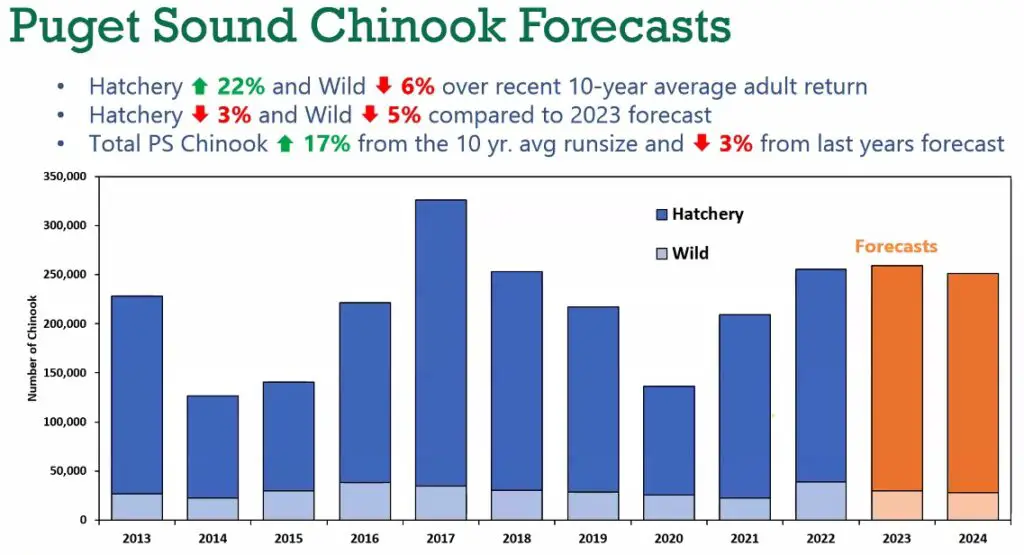
2024 is expected to be a decent year! Wild chinook are still struggling and that will continue to cause us problems, but with our mark-selective approach we do not have much impact on wild chinook at all, and by buying a license and fishing you support all of the management that protects and fosters the rebound of these chinook stocks.
Don’t listen to those people who tell you to not fish because the Orcas are starving, they have absolutely not clue what they’re talking about.
Also, don’t listen to those people who say fishing sucks and they are going to sell their boat and not buy a license.
Things are not ideal or even optimal, but there’s still a really good opportunity to catch lots of chinook in Puget Sound this year for most folks.
What about Coho?
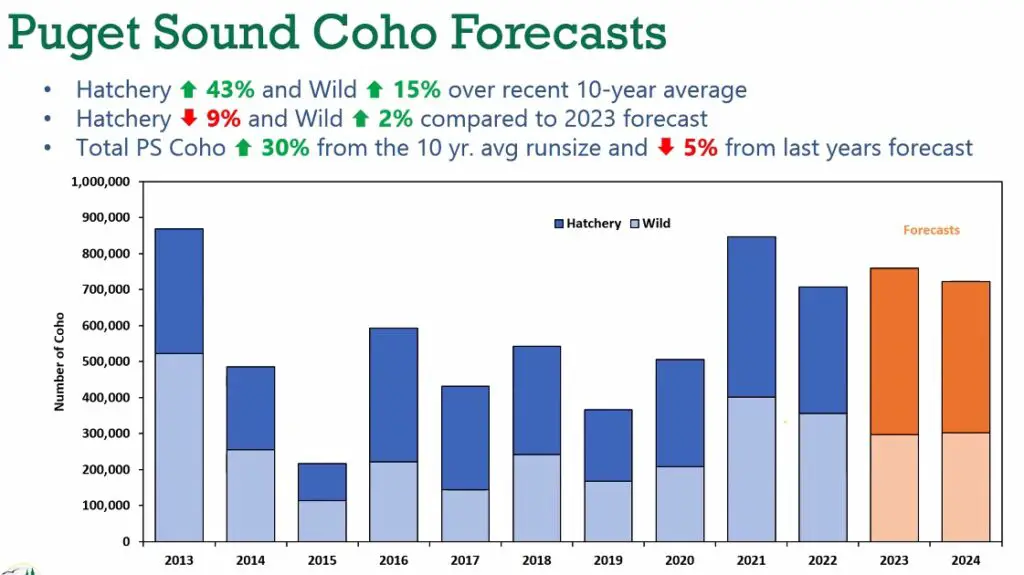
Coho is also expected to be solid in 2024!
Again, expect to get all kinds of unpleasant surprises along the way with our in-season management structures, but the key is to stay engaged. Stay involved. Keep fishing. Keep taking your kids and other people’s kids fishing.
We have a long way to go towards a 2024 salmon fishing season in Puget Sound and in the rivers, but there’s a lot of good news in these forecasts.
I’m going to stay involved to the full extent that I can and advocate for our opportunity. I’m also planning to have one helluva 2024 salmon fishing season on Puget Sound!
Stay tuned!
Looking for tips about Puget Sound Salmon Fishing and how to do it well? Take a look at our comprehensive how-to on Puget Sound Salmon Fishing here.
Thanks for all your hard work on this Kyle. Any thoughts on why the numbers are not higher given then number of smolts released a few years ago to help the Orcas?
I just reviewed the bar graph of the last 10 years of chinook runsize in Puget Sound and the most recent 4 years are better than any other 4-year period in that timeframe. I think it’s challenging to judge though because every year is slightly different.
And the SRKW smolt plant increase was for specific hatcheries. I would have to look that up and see how the return in those specific hatcheries has changed.
Generally speaking, more smolt plants =’s more returning salmon, but not always…We’ve got a massive predator problem across Puget Sound that takes a lot of these fish.
Perhaps we should measure total seal and sea lion poo as another indicator of how many fish we are raising and releasing 🙂